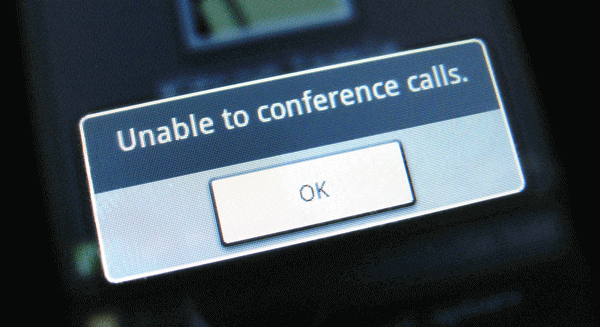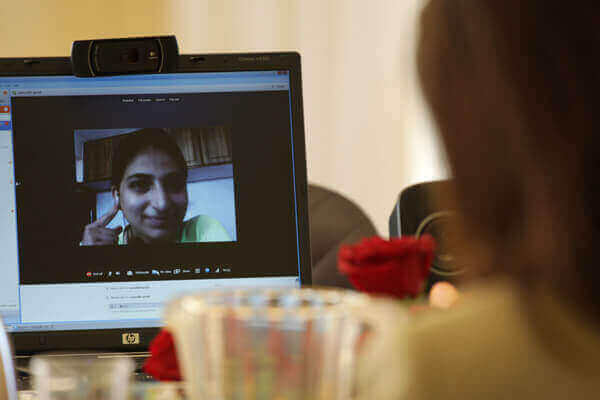By JM Webster
Do you find conference calls difficult? Do you become stressed during the call? Do you freeze when you have to speak?
You’re not alone – many people find them difficult.
When you think about conference calls which of the following problems causes you anxiety:
• I don’t understand the accent of Mr McKay from Scotland / Mr Chopra from India.
• Too many people talk at the same time.
• If I don’t understand 1 or 2 words, I lose the meaning of the conversation.
• My English isn’t good enough / I freeze when I have to speak English
• The technology is difficult to use.
Sound familiar?

This article will help you overcome these problems and provides some useful tips and common English phrases to help you with your next call.
We will look at 3 distinct areas:
- Getting ready – preparation is key.
- Useful phrases – easy and commonly used English expressions that help you manage the call.
- Example of a conference call – using these phrases we will simulate a typical call so you can see how they come together.
Part 1: Getting ready
Look at the video below and you will see some common problems with conference calls. Perhaps you have experienced some of them:
To help things run more smoothly than in that video, follow these 5 simple steps before the call. They may sound simple but they will increase the chance of having an effective meeting:
1. Make sure you have a copy of the agenda and understand the topics to be covered.
2. Do you know who is attending the call? Which nationalities will be represented and have you experienced difficulty with their accents in the past?
If so, learn a few useful phrases so you can ask the person to speak more slowly or repeat the sentence (see below). Be careful not to refer to the accent directly, as this may offend.

3. Are you required to speak? Know what is expected of you and prepare your presentation, report etc. in advance. Practise as much as possible before the meeting. The more you practise the more confident you will be.
You could also think of questions you may be asked during the meeting. Prepare possible answers in advance so you are less nervous on the day. (If making presentations makes you nervous, why not take a look at our guide to public speaking.)
4. Practise your listening skills regularly. Try to listen to a range of accents – British, American, Australian etc.. It may sound obvious but the more you listen to English the easier it becomes. You will naturally become more confident and less likely to panic when you don’t understand 1 or 2 words.
Why not try the following websites to practise your listening skills – the BBC’s Learning English, or for an American accent, or speaking more slowly.

5. Technology can always present challenges, but we can minimise any panic with a little preparation:
- Before the call locate the conference room, test the equipment and verify the PIN number and access code.
- Know the right buttons to press – where is the mute button / volume button/ speaker button?
Part 2: Useful phrases
Now you’re ready to start.
A conference call can be divided into clear parts, for example: starting the meeting, finishing the meeting, dealing with audio problems, etc..
Below you will find useful phrases for each of these sections, to help you start, finish and navigate a successful call.
In the left column you will see the call divided into sections. In the right column you will see typical expressions that you can use in each section.
|
Starting the meeting Each participant should announce their presence. If you are running the meeting each participant should be welcomed individually. Make sure all invitees are present. Check the pronunciation of difficult names. New members should be introduced to other participants. | Greetings: – Good morning. This is Alex from the Paris office.- Good afternoon. Rachel speaking. Attendance: – Before we start, please could you introduce yourselves? Checking names: – Ralph speaking. The correct pronunciation is RAYF. Introducing new members: – I’d like to introduce Paul. He’s in charge of Sales in the Paris office. |
|
Setting ground rules Remind participants to speak clearly right from the start. Avoid too many people speaking at the same time. Remind participants how to use the technology. | Maximising understanding: – We have 3 nationalities here today. Please speak clearly and slowly so that everyone understands. Technology: – Could you check your microphone please? |
|
Dealing with problems Make sure all participants can hear well. Let the other attendees know when you are experiencing problems with sound. Politely ask the caller to repeat if you have difficulty understanding. |
Checking the volume: – Can you hear me ok? Problems with sound: – I can’t hear very well. Understanding accents: – I’m sorry John, but I’m afraid I didn’t understand. Please could you repeat that? Understanding part of a sentence: – I’m sorry Mr McKay but I didn’t catch that. Could you repeat that please? Multiple voices: – There are two people speaking. Mr Chopra, can you continue? John, we’ll come back to you in a moment. |
|
Setting objectives Clearly state the purpose of the meeting at the beginning of the call. | Examples: – The purpose of today’s meeting is to review last month’s sales. |
|
Referring to documents Participants can’t see you so you have to be able to describe them clearly. | Examples: – You should have a green document in front of you entitled ‘European Customer Satisfaction’ |
| Sharing opinions | Asking for an opinion: – Shall we go round the table and hear everyone’s opinion? Expressing an opinion: – In my opinion, we are performing well under the circumstances. Agreeing: – I agree Disagreeing: – I’m sorry but I’m afraid I disagree. Checking for understanding: – So what you’re saying is, we need to increase sales. Compromising: – Let’s try to find a middle ground. Making a suggestion: – Maybe we could increase the budget. Agreeing with a suggestion: – That’s a good idea. Showing understanding: – I understand. Interrupting someone: – I’m sorry to interrupt. It’s Susan here. |
|
Managing speakers Tell callers to clearly state their name before speaking. Make sure everyone has a chance to speak. | Clarifying who is speaking: – Sorry. Who’s speaking please? Inviting participants to speak: – Pauline, what are your thoughts? |
|
Managing time Be aware of the time restrictions and make sure everyone else knows too. | Respecting the schedule: – May I remind everyone that we have to finish by 4pm. Bringing the discussion to an end: – I’m afraid we’re running out of time. |
|
Closing the meeting Summarise the key decisions and action points. Make sure everyone knows the next steps, individual actions to be taken, and relevant deadlines. | Summarising: – So, let’s go over the main points. Highlighting action points: – So Alex, you’re going to send out the minutes. Rachel, you’re going to speak to the regional Manager. Refer to a future call: – Shall we schedule a follow-up call in 2 weeks? |
Try to learn some of the phrases before your next conference call – it will help boost your confidence.
You can also download a PDF copy of the complete list of useful phrases:
Download the Conference Calls phraselist
Part 3: Participating in a conference call

So you have a list of commonly used English expressions. Now let’s see how they come together in a real conference call.
Below you will find a simulation in which the attendees use the above phrases.
Four people are talking about customer service, and they are calling from Paris, Milan and London.
Can you find the useful expressions from the list above in the dialogue below? Note how these phrases are used to start the meeting, set ground rules, deal with problems, manage time, and finish the meeting.
Introductions
Chairman: Good morning. This is Alex, Customer Service Manager from the Paris office. Before we start, please could you introduce yourselves.
Milan: Good morning. This is Ralph speaking, but the correct pronunciation is Rayf. I’m the Customer Service Manager in Milan.
London: Good morning everyone. This is John, Finance Manager, London.
London 2: Good morning. John speaking. I’m the Customer Service Manager in the London office.
Chairman: Welcome everyone and thank you for attending. I’m afraid Vladimir is unable to attend today so we will have to proceed without him. As you may have noticed we have two Johns with us today. Please could we add surnames when speaking – John Smith and John Taylor?
London: Good idea.
London 2: Agreed!
Setting ground rules
Chairman: Before we address the points on the agenda, please remember to switch off the mute button when you are speaking. Switch it on when you’re not speaking. I should highlight that we have three nationalities here today and not everyone is a native English speaker. Please speak clearly and slowly so that everyone understands. Furthermore, please speak one at a time to avoid confusion.
Dealing with sound issues
London: John Taylor here. I can’t hear you very well Alex. Please could you check your microphone?
Chairman: Yes of course. I’ve increased the volume. Can you hear me now?
London: Yes that’s much better.
Setting objectives and referring to documents
Chairman: So, as agreed, Ralph will be taking notes throughout today’s meeting. The purpose of today’s meeting is to review the level of customer satisfaction across Europe and propose changes moving forward. You should have a green document in front of you entitled European Customer Satisfaction. John Smith is going to present the main highlights.
London 2: Thank you Alex. Please could you all turn to Page 2. You will see that the main points are highlighted in bold in paragraph 3 and 4. Clearly customer satisfaction has decreased dramatically over the past year. There was a drop during the Christmas period followed by a slight decrease in Spring… Thank you for listening.
(For more advice on making a presentation in English see our guide here.)
Sharing opinions
Chairman: Thank you John. Shall we go round the table and hear everyone’s opinion on the results? Let’s start with Ralph.
Milan: Well, in my opinion we’re performing well under the circumstances. There is a lot of work and we are understaffed. We need a bigger budget in order to hire more staff.
London: John Taylor here. I’m sorry to interrupt but I completely disagree. I don’t think you need a bigger budget. That’s out of the question. In my opinion we need better training.
Dealing with sound issues
Chairman: What do you think John Smith?….John? John can you hear me? John you need to switch off the mute button if you want to speak.
Sharing opinions and finding a compromise
London 2: Ah yes! John here. As I was saying, I agree with Ralph to a certain extent but we have to keep costs down due to the current economic climate. We need to think creatively and try to find a compromise.
Milan: Ralph here. I see your point John. Let’s try to find a middle ground. Maybe we could increase staff training for a trial period of, say 6 months, and then test the impact on customer service. If necessary we could return to the topic of a bigger budget after 6 months. What do think?
London: John Taylor here. I think that’s a good idea.
London 2: John Smith here. I completely agree.
Managing time
Chairman: Would anyone like to add anything before we finish the call? Unfortunately time has run out for today.
Milan: Ralph here. I think we’ve covered everything. We’ve reached a good compromise.
Closing the meeting
Chairman: Before we close the meeting, let’s go over the main points. Firstly, we reviewed the customer service results, then we discussed options…
Chairman: So John Smith you’re going to speak to the HR Department regarding further staff training. John Taylor you’re going to let us know how much money is available for further training over the next 6 months. Ralph you’ll circulate the minutes to everyone within 48 hours. Shall we schedule a follow-up call next month? Thank you all for coming.
This dialogue shows you how the list of useful expressions above come together. So how many expressions from the previous list did they use?
If you counted 20, well done!
If you found a different number, why not download the list of useful phrases, place it side by side, and re-read the dialogue above again.
Conclusion

Using simple, effective phrases will be appreciated both by your colleagues and by management – clear, simple phrases are much easier to understand for everyone, and in Anglo-Saxon business culture it is a sign of intelligence, empathy and understanding a topic well.
So to reduce the stress and anxiety of conference calls follow these steps:
- Have the agenda and prepare any presentations in advance
- Test the technology and access codes in advance
- Learn and review the common English expressions above
Now we would love to hear from you.
Do you have any other tips about conference calls that you would like to share, or useful expressions that have helped you in the past?
How many expressions did you find in the dialogue above? Did you have difficulty understanding any of the expressions? Let us know in the comments box below!
